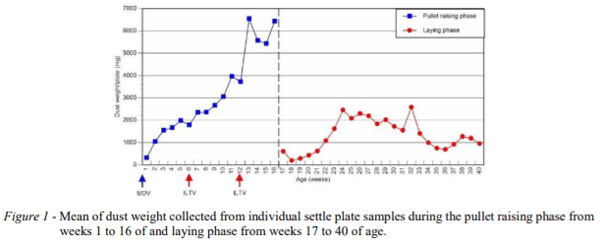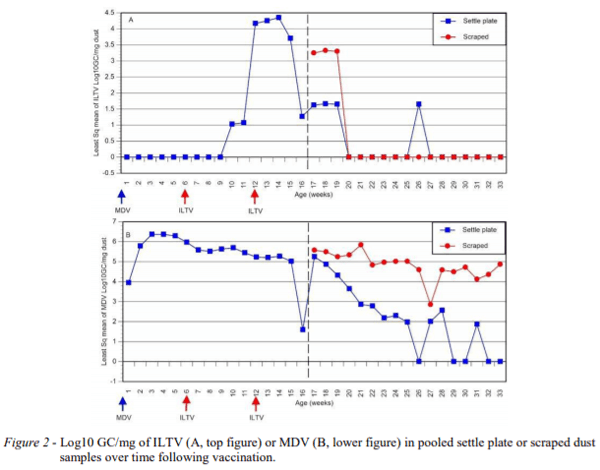I. INTRODUCTION
Marek’s disease virus (MDV) and infectious laryngotracheitis virus (ILTV) are two economically important viruses of subfamily Alphaherpesvirinae. MDV is an extremely contagious virus which can cause severe oncogenic changes in viscera and tissues and high mortality in chicken while ILTV causes serious respiratory disease in chickens. Routine surveillance of MDV in poultry dust by quantitative PCR (qPCR) has been successfully used by industry for monitoring MDV presence in Australia (Walkden-Brown et al., 2013) and in the USA (Kennedy et al., 2017). Dust samples can be collected on settle plates or scraped from barn surfaces. Kennedy et al. (2017) suggest that both sampling methods could be biased, but the spatial artefacts from settle plates could be avoided by using the scraped method. This same approach could be used in commercial chicken flocks to investigate vaccination success for other pathogens. In fact, Roy et al. (2015) has shown that ILTV vaccine strains can be found at high levels in dust samples under experimental conditions. This study was therefore designed to investigate MDV and ILTV vaccine viral load following vaccination in dust samples collected by settle plates or scraped from surfaces. Variation in the weight of dust collected over time was also analysed.
II. METHOD
The experiment used 1700 Hy-Line Brown chicks raised from day old and included two phases, pullet raising (0 to 16 weeks of age) and laying (17 to 40 weeks of age) in different poultry houses and conditions. During the pullet raising phase chicks were reared in a shed with three separate rooms with no common air space. In each room, around 570 Hy-Line Brown chicks were raised from day old. Each room was 6.25 x 9.78 m, with two doors, two circulating fans, 1 roof fan and 4 double mini-vents. The air was pulled into the shed through double mini-vents and exhausted through the roof fans. Chicks were reared on rice hulls for bedding. At day old, chicks were vaccinated against MDV serotype 1 Rispens CVI988 (Vaxsafe RIS, Bioproperties Pty Ltd) by subcutaneous injection. The birds were vaccinated against ILTV with A20 strain (Poulvac Laryngo A20) by drinking water at 6 weeks of age and with SA-2 (Poulvac Laryngo SA2) by eye drop at 12 weeks.
At 16 weeks of age, the pullets were moved to an experimental free-range laying shed with rice hulls as bedding. Within the shed, birds were housed in 9 chicken mesh and shade cloth sided pens with 154 chickens/pen in a space of 17.28 m2. The pens shared a common air space, but 4 pens had exhaust fan in them while the remaining 5 did not. Each pen had a single chicken mesh door and 3 pop-holes that connected the pen with a free-range area outside. The pop-holes were opened between 9 h and 18 h from 25 weeks of age onwards.
Dust samples were collected from settle plates (surface area 520 cm2) suspended at a height of approximately 1.4 m. Dust samples were collected weekly from 4 sites per pen in the pullet raising phase and 2 sites per pen in the laying phase. A single pooled dust sample from all sites was created each week. Samples were stored in plastic ziplock bags at −20°C.
Following thorough mixing of dust pools, DNA was extracted from 5 mg of dust using the Bio-line ISOLATE II Genomic DNA kit (Roy et al., 2015). Extracts were tested by qPCR for ILTV (Callison et al., 2007) and MDV (Islam et al., 2006). Results were reported in log10 genomic copies (GC). Statistical analyses were conducted using JMP 13 (SAS Institute Inc., Cary NC, USA). The effects of week of age and sampling method on dust weight and viral GC were tested using appropriate analyses of variance (ANOVA).
III. RESULTS
The weight of dust collected from settle plates increased rapidly during the pullet raising phase while it was lower during the laying phase, when birds were at a lower density (Figure 1). In the pullet raising phase, the weight of dust per plate rapidly increased from 316 mg at week 1 and peaked at week 13 with 6538 mg (P < 0.0001). In both periods there was a highly significant effect of bird age on dust weight (P < 0.0001).
In the pullet raising phase, ILTV was first detected in dust at week 10 and peaked at week 14, 3 weeks after second vaccination (Figure 2). There was a significant effect of bird age on ILTV GC (P < 0.0001). During the laying phase ILTV was detected in both settle plate and scraped samples from weeks 17-19 becoming negative thereafter apart from a positive settle plate sample at week 26. There was no significant difference in the number of ILTV positive samples (P = 0.28) or ILTV GC (P = 0.30) between settle plate and scraped samples.
MDV GC in dust also varied significantly with chicken age during the pullet raising phase (P < 0.0001). The first positive detection was at week 1 with a peak in week 3 followed by a slow decline over the next 12 weeks (Figure 2). In the laying phase, MDV GC in settle plate samples reduced rapidly. This decline was not evident in scraped samples resulting in a significantly higher number of MDV positive samples (P < 0.01) and MDV GC (P < 0.0001, 2.15 and 4.82 respectively) compared to settle plate samples.
IV. DISCUSSION
The amount of dust collected at all times was far in excess of the 5mg used for DNA extraction, so that collection intervals of less than one week would be possible, particularly from two weeks of age onwards. The dust in poultry houses is a complex combination of materials including feed and avian excreta such as faeces, skin and feather (Ralapanawe et al., 2016) with animals themselves the most important dust source (Ellen et al., 2000). The increase in dust production during the raising phase reflects the increased breakdown of litter materials and increase in bird excretion. The marked reduction in dust amount during the laying phase is probably due the lower bird density in this phase with fluctuations due to differences in ventilation rate and range use by the chickens.
With regard to ILTV detection in dust, there was a low shedding after water vaccination at week 6 (A20 strain), but a higher shedding after eye drop vaccination at week 12 (SA2 strain). These differences may be due to the different vaccines used and to the different vaccination methods, with eye drop vaccination resulting in a better vaccination success. The dust results are consistent with the initial report of Roy et al. (2015) of ILTV detection in isolator dust from vaccinated birds. Ahaduzzaman et al (2019) have shown that ILTV GC levels in dust following ILT vaccination of broilers in water relate well to variable vaccine take assessed in individual birds as reported by Groves et al., (2019). The origin of the virus in the dust is unclear but Roy et al., (2015) reported high levels of ILTV GC in the faeces following vaccination and this is one potential source. Overall, these results indicate that measurement of ILTV in dust 1-3 weeks after vaccination may be an effective method of assessing vaccination success in layers. The low sample number (one pooled sample), ease of collection and transport (no cold chain required) and moderate cost (approx $100) would assist in making it practical under commercial conditions. The single positive at week 26 may represent a release from latency and this requires further investigation.
With regard to MDV there was a peak in viral load 3 weeks post vaccination but with a much more prolonged shedding period of some 25 weeks. The decline in MDV shedding from week 17 detected in settle plate samples was masked in the scraped samples which appear to provide a mean viral load value over the period of dust accumulation at the site, rather than the current levels of MDV in dust. This may explain the longer persistence of MDV Rispens shedding in scraped samples reported by Ralapanawe et al. (2016). For either virus, dust samples collected in settle plate over a fixed period of time have the advantage of reflecting current viral load in dust samples, when compared to scraped dust samples that may reflect historical accumulation.
ACKNOWLEDGEMENTS: We thank PoultryHub for funding support, Peter Scott and Nilhan Fernando from Scolexia for vaccination advice and support and Tim Dyall from CSIRO and Andrew Cohen-Barnhouse from UNE for lead technical support.
Abstract presented at the 30th Annual Australian Poultry Science Symposium 2019. For information on the latest edition and future events, check out https://www.apss2021.com.au/. 









